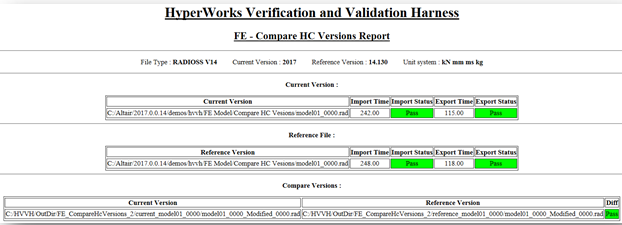In this tutorial, you will learn how to:
| • | Perform model setup in HyperMesh and identify any problems during the interactive HyperMesh operation. |
Step 1: FE-Model setup, first use case.
| 1. | From FE Model tab, select the Model Setup tab. |
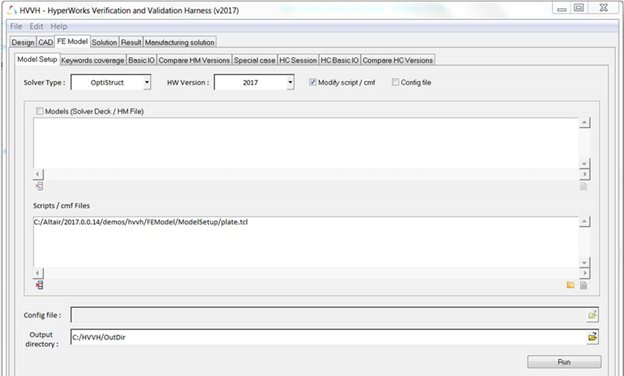
| 2. | For Solver Type, select OptiStruct. |
| 3. | For HW Version, select 2017. |
| 4. | Activate the Modify script/cmf check box. |
| 5. | Do not select the Config file or Models option. |
| 6. | Under Scripts/cmf files, use the file browser icon,  , or the add file icon, , or the add file icon,  , to select and open the Plate.tcl file, located in , to select and open the Plate.tcl file, located in
..\tutorials\hvvh\FEModel\ModelSetup. |
| 7. | For the Output directory field, use the open file icon,  , to select an output directory. , to select an output directory. |
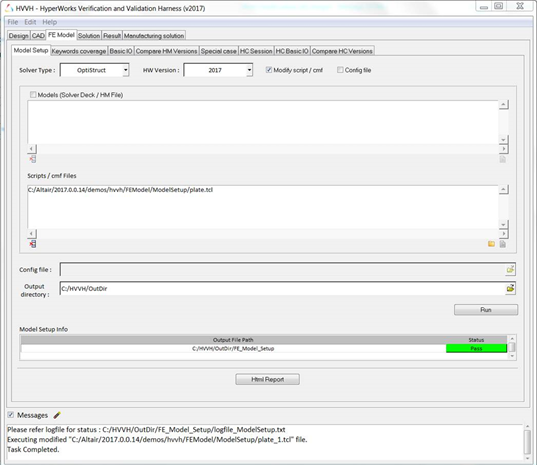
The model file with the script is imported and a set of operations in HyperMesh are executed. The status is displayed under Model Setup info.
| 9. | If the selected Tcl file is executed correctly and there are no problems with the HyperMesh operations, the status shows Pass. |
| 10. | In the Messages window, the run details are displayed along with the log file location. |
| 11. | Click HTML Report to open an HTML report, which contains details of the script executed HyperMesh. |
Step 2: FE-Model setup, second use case.
| 1. | From FE Model tab, select the Model Setup tab. |
| 2. | For Solver Type, select OptiStruct. |
| 3. | For HW Version, select 2017. |
| 4. | Activate the Modify script/cmf and Config file check boxes. |
| 5. | Do not select the Models option. |
| 6. | Under Scripts/cmf files, use the file browser icon,  , or the add file icon, , or the add file icon,  , to select and open the Plate.tcl file, located in , to select and open the Plate.tcl file, located in
..\tutorials\hvvh\FEModel\ModelSetup. |
| 7. | For Config file, use the file browser icon,  , to open the Model_setup_cfg.txt file, located in ..\tutorials\hvvh\FEModel\ModelSetup. , to open the Model_setup_cfg.txt file, located in ..\tutorials\hvvh\FEModel\ModelSetup. |
| 8. | For the Output directory field, use the open file icon,  , to select an output directory. , to select an output directory. |
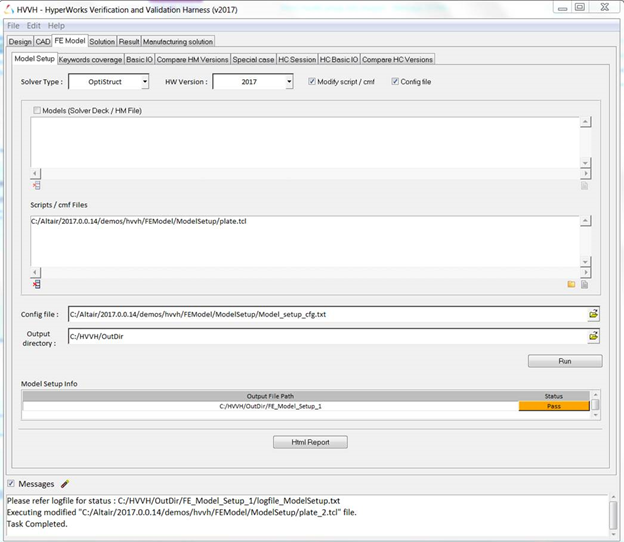
The model file with the script is imported and a set of operations in HyperMesh are executed. The status is displayed under Model Setup Info.
When you select the config file, the operation is interactive and HyperMesh starts, allowing you to see the model's interactive operations.
| 10. | If the selected Tcl file is executed correctly and there are no problems with the HyperMesh operations, the status displays Pass. If there are additional lines at the end of the command.tcl file that are generated compared to the original script, it is highlighted in orange as a warning. |
| 11. | In the Messages window, the run details are displayed along with the log file location. |
| 12. | Click HTML Report to open an HTML report, which contains details of the script executed HyperMesh. |
Step 3: Generate keyword coverage summary.
Extract the details of supported, unsupported, and partially supported keywords from the solver analysis decks
| 1. | From FE Model tab, select the Keywords coverage tab. |
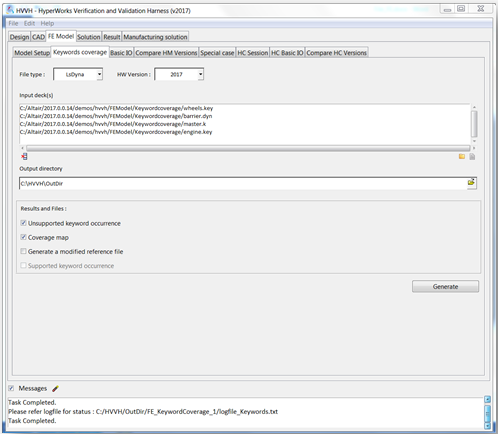
| 2. | For File Type, select LsDyna. |
| 3. | For HW Version, select 2017. |
| 4. | Under Input deck(s), use the file browser icon,  , or the add file icon, , or the add file icon,  , to select and open the following files: , to select and open the following files: |
..\tutorials\hvvh\FEModel\Keywordcoverage\barrier.dyn
..\tutorials\hvvh\FEModel\Keywordcoverage\engine.key
..\tutorials\hvvh\FEModel\Keywordcoverage\master.k
..\tutorials\hvvh\FEModel\Keywordcoverage\wheels.key
| 5. | For the Output directory field, use the open file icon,  , to select an output directory. , to select an output directory. |
From the imported solver decks, supported, unsupported, and partially supported keywords are generated.
| 7. | In the Messages window, the run details are displayed along with the log file location. |
| 8. | Click the pie chart to view details regarding the published files, as well as to see details in a document of supported, unsupported, and partially supported keywords based on the analysis decks. All individual and combined files are listed in the document. |
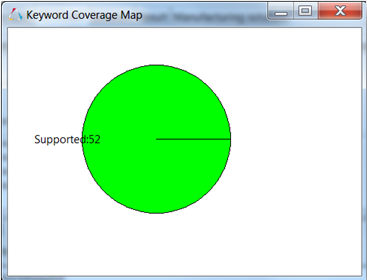
Step 4: Basic import and export.
Identify any loss of data during solver import and export.
| 1. | From FE Model tab, select the Basic IO tab. |
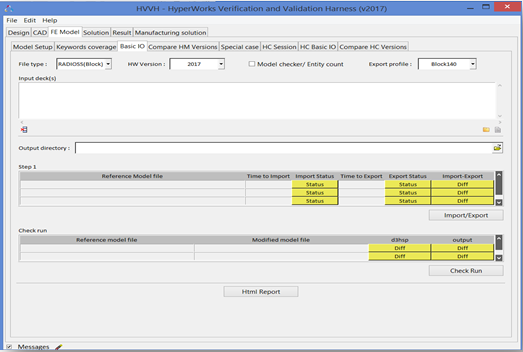
| 2. | For File Type, select OptiStruct. |
| 3. | For HW Version, select 2017. |
| 4. | Activate the Model Checker/Entity count option. |
| 5. | Use the default Export profile. |
| 6. | Under Input deck(s), use the file browser icon,  , or the add file icon, , or the add file icon,  , to select and open the following files: , to select and open the following files: |
..\tutorials\hvvh\FEModel\BasicIO\buckling1.fem
..\tutorials\hvvh\FEModel\BasicIO\car1.fem
| 7. | For the Output directory field, use the open file icon,  , to select an output directory. , to select an output directory. |
Under Step 1, the import and export time and status (pass or fail) of the reference model file (selected above) are displayed.
The last column gives information on the ASCII difference between the imported file and HyperMesh exported file. If there are no differences, it is displayed as Pass, otherwise, it's show as Fail.
Step 2 displays the import and export time and status (pass or fail) of the exported model file that is re-imported back into HyperMesh (along with the import and export status and time).
The last column displays information on the ASCII difference between the model checker summary of the file in steps 1 and 2. Any loss of data is identified.
| 10. | The original model and the HyperMesh exported models are run with the RADIOSS solver. The OUT file blocks are compared as shown in the status. |
| 11. | In the Messages window, the run details are displayed along with the log file location. |
| 13. | Click HTML Report to open an HTML report. |
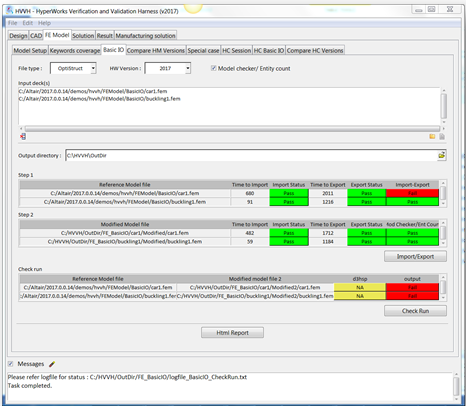
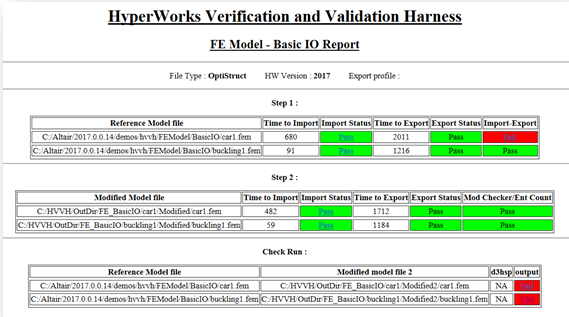
Step 5: Compare HyperMesh versions.
Compare the analysis decks exported using different versions of HyperMesh.
| 1. | From FE Model tab, select the Compare HM Versions tab. |
| 2. | For File Type, select OptiStruct. |
| 3. | For Current Version, select 2017. |
| 4. | For Reference version, select 14.0.0.130 (should also be installed). |
| 5. | Under Input deck(s), use the file browser icon,  , or the add file icon, , or the add file icon,  , to select and open the following files: , to select and open the following files: |
..\tutorials\hvvh\FEModel\CompareHMVersions\buckling1.fem
..\tutorials\hvvh\FEModel\CompareHMVersions\car1.fem
| 6. | For the Output directory field, use the open file icon,  , to select an output directory. , to select an output directory. |
| 8. | The first table details the import and export time and status (pass or fail) of the model file selected in the current version. |
The second table details the import and export time and status (pass or fail) of the model file selected in the reference version.
The last column displays information on the ASCII difference between the exported files in the current and reference versions of HyperMesh. If there are no differences, it is displayed as Pass, otherwise, it's shown as Fail.
| 9. | In the Messages window, the run details are displayed along with the log file location. |
| 10. | Click HTML Report to open an HTML report. |
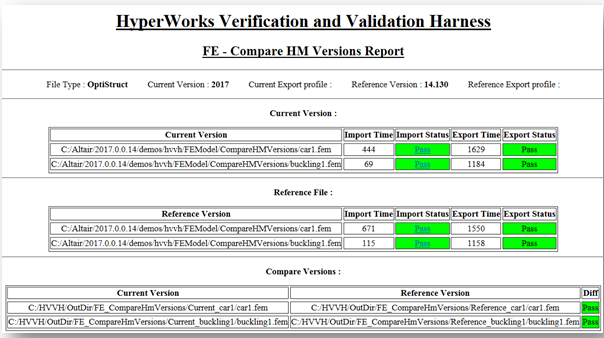
Step 6: Special case: compare HyperMesh exported decks based on FE entities.
Compare the data of solver deck in a non-HyperMesh format after import and export with different options for any loss of data.
| 1. | From FE Model tab, select the Special case tab. |
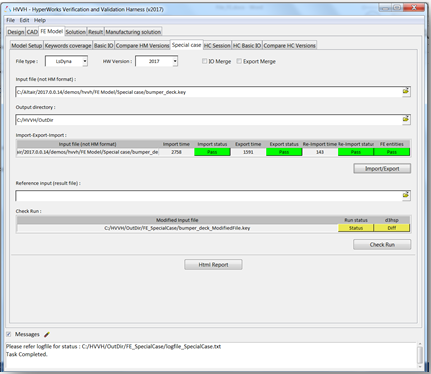
| 2. | For File Type, select LsDyna. |
| 3. | For HW Version, select 2017. |
| 4. | Do not select the IO Merge and Export Merge options. |
| 5. | Under Input deck(s), use the file browser icon,  , or the add file icon, , or the add file icon,  , to select and open the following file: , to select and open the following file: |
..\FE Model\Special case\bumper_deck.key.
| 6. | For the Output directory field, use the open file icon,  , to select an output directory. , to select an output directory. |
The first table details the import and export times and status (pass or fail) of the model file in the HyperMesh version selected.
The file is re-imported and the status is displayed under Re-import status.
FE entities are compared with the original solver deck. Any changes in data shows any loss of data, otherwise it is shown to pass.
| 8. | In the Messages window, the run details are displayed along with the log file location. |
| 9. | Click HTML Report to open an HTML report. |

Step 7: Check interactive operations in HyperCrash and compare the exported files.
Use the session recording option in HyperCrash to check interactive operations.
| 1. | From FE Model tab, select the HC Session tab. |
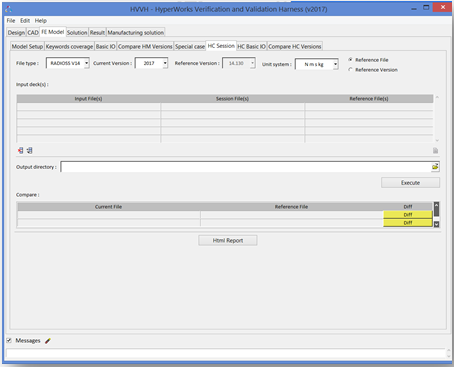
| 2. | For File Type, select RADIOSS v2017. |
| 3. | For Current Version, select 2017. |
| 4. | Activate the Reference file option. |
| 5. | Under Input File, use the add file icon,  , to select and open the following file: , to select and open the following file: |
...\tutorials\hvvh\FEModel\HCSession\FOAMD00_v14_0000.rad file
| 6. | Under Session File, use the add file icon,  , to select and open the following file: , to select and open the following file: |
...\tutorials\hvvh\FEModel\HCSession\Position.xml
| 7. | Under Reference File, use the add file icon,  , to select and open the following file: , to select and open the following file: |
...\tutorials\hvvh\FEModel\HCSession\FOAM_Dummy_Reference_0000.rad
| 8. | For the Output directory field, use the open file icon,  , to select an output directory. , to select an output directory. |
The input file is imported in HyperCrash. Using the session file, a set of interactive operations are executed inside HyperCrash and the file is exported.
In the Compare table, the Diff column displays information on the ASCII difference between this exported file and the current and reference files selected above. If there are no differences, it is shown as Pass, otherwise, Fail.
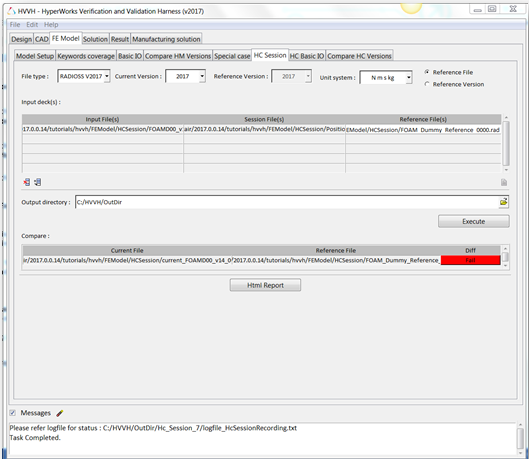
| 10. | In the Messages window, the run details are displayed along with the log file location. |
| 11. | Click HTML Report to open an HTML report. |

The difference between the exported files are not major.
Step 8: HyperCrash basic import and export.
Identify any loss of data during HyperCrash basic import and export.
| 1. | From FE Model tab, select the HC Basic IO tab. |
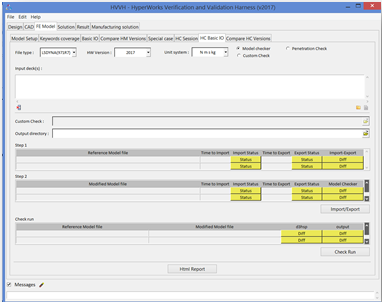
| 2. | For File type, select RADIOSS v2017. |
| 3. | For HW Version, select 2017. |
| 4. | For Unit system, select kN-mm-ms-kg. |
| 5. | Activate the Model checker option. |
| 6. | Under Input deck(s), use the file browser icon,  , or the add file icon, , or the add file icon,  , to select and open the following file: , to select and open the following file: |
..\tutorials\hvvh\FEModel\HCBasic IO\model01_0000.rad
| 7. | For the Output directory field, use the open file icon,  , to select an output directory. , to select an output directory. |
Under Step 1, the import and export time and status details (pass or fail) of the reference model file (selected above) are displayed.
The last column displays information on the ASCII difference between the imported file and HyperCrash exported file. If there are no differences, it is displayed as Pass, otherwise, it's show as Fail.
Step 2 displays the import and export time and status (pass or fail) of the exported model file that is re-imported back into HyperCrash (along with the import and export status and time).
The last column displays information on the ASCII difference between the model checker summary file in steps 1 and 2. Any loss of data is identified
The original model and the HyperCrash exported models are run with the RADIOSS solver. The RADIOSS starter OUT file blocks are compared as shown in the status.
| 10. | In the Messages window, the run details are displayed along with the log file location. |
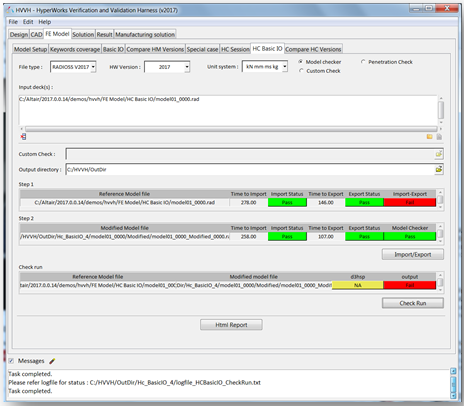
| 11. | Click HTML Report to open an HTML report. |
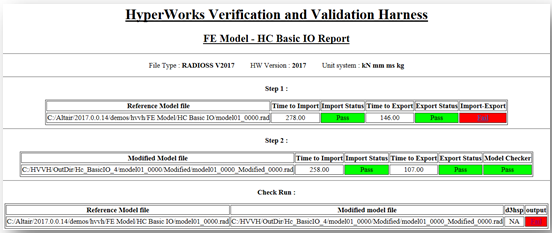
Step 9: Compare HyperCrash versions.
Compare the analysis decks exported in different versions of HyperCrash.
| 1. | From FE Model tab, select the Compare HC versions tab. |
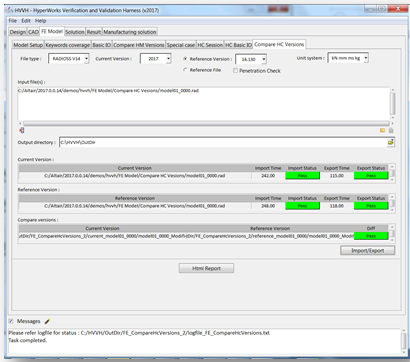
| 2. | For File type, select RADIOSS v14. |
| 3. | For Current Version, select 2017. |
| 4. | For Reference Version, select 14.0.0.130. |
| 5. | For Select Unit System, select kN-mm-ms-kg. |
| 6. | Under Input deck(s), use the file browser icon,  , or the add file icon, , or the add file icon,  , to select and open the following file: , to select and open the following file: |
..\tutorials\hvvh\FEModel\CompareHCVersions\model01_0000.rad
| 7. | For the Output directory field, use the open file icon,  , to select an output directory. , to select an output directory. |
The first table details the import and export time and status (pass or fail) of the model file selected in the current version.
The second table details the import and export time and status (pass or fail) of the model file selected in the reference version.
The last column displays information on the ASCII difference between the exported files in the current and reference versions of HyperCrash. If there are no differences, it is displayed as Pass, otherwise, it's show as Fail.
| 9. | In the Messages window, the run details are displayed along with the log file location. |
| 10. | Click HTML Report to open an HTML report. |
